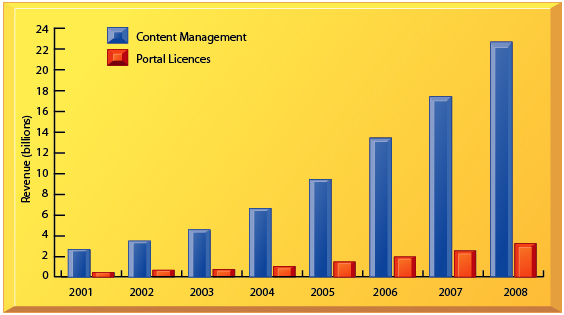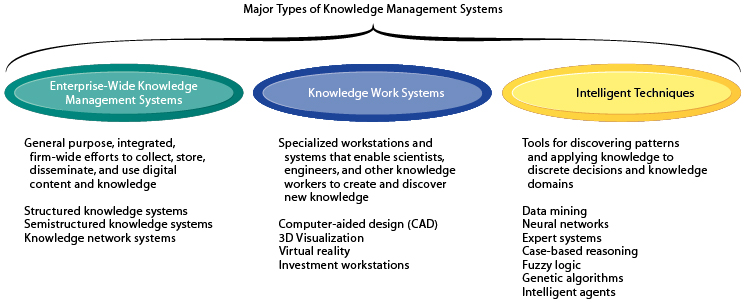| Section 11.1: Bullet Text Study Guide |
The Knowledge Management Landscape
Knowledge management systems have become one of the fastest-growing areas of corporate and government software investment.
Figure 11-1
 |
|
Studies have found that a substantial part of a firm's stock market value is related to its intangible assets, of which knowledge is one important component, along with brands, reputations, and unique business processes. Knowledge-based projects have been known to produce extraordinary returns on investment, although knowledge-based investments are difficult to measure.
To transform information into knowledge, a firm must expend additional resources to discover patterns, rules, and contexts where the knowledge works. Wisdom is thought to be the collective and individual experience of applying knowledge to the solution of problems.
Tacit knowledge is knowledge residing in the minds of employees that has not been documented.
Explicit knowledge is knowledge that has been documented.
The most important dimensions of knowledge are:
- Knowledge is a firm asset: Knowledge is an intangible asset requiring organizational resources and whose value increases as it is shared.
- Knowledge has different forms: Knowledge includes craft, skills, procedures, and understanding of causality
- Knowledge has a location: Knowledge resides with individuals, social groups, is difficult to transfer or extract
- Knowledge is situational: Knowledge may be applicable only in certain contexts or situations
Organizational learning is the process of gaining experience through data collection, measurement, experiment, and feedback and using these experiences to create new business processes and management decision making.
Knowledge management is a set of processes to create, store, transfer, and apply knowledge in the organization. Knowledge management increases the ability of the organization to learn from its environment and to incorporate knowledge into its business processes. The knowledge management value chain includes four main steps that add value to raw data and information as it is transformed into usable knowledge:
- Knowledge acquisition: Knowledge may be acquired by building repositories of documents, enabling systems for expert advice, analyzing data for patterns, or by using knowledge workstations. An effective knowledge system requires systematic data from a firm's transaction processing systems and data from external sources.
- Knowledge storage: Storing knowledge in databases and document management systems
- Knowledge dissemination: Knowledge may be transferred to managers and employees via portals, e-mails, search engines, collaborative office systems, training programs, and other means.
- Knowledge application: New knowledge must be built into an organizations processes and application systems and become a part of decision-making systems.
For each step, management and organizational activities, or organizational capital, are required to obtain returns on IT investments and systems used for that step.
Figure 11-2
 |
|
Effective knowledge management systems require organizational and management capital to promote a "knowledge culture" and programs for knowledge management, including the creation of a chief knowledge officer (CKO) and communities of practice (COPs).
There are three major types of knowledge management systems:
- Enterprise-wide knowledge management systems
- Knowledge work systems
- Intelligent techniques
Figure 11-3
 |
|